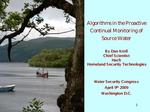Description
The Long Beach Water Department (LBWD) is engaged in significant testing for reducing thecosts associated with operating desalting membranes, including using nanofiltrationmembranes arranged in a two-pass configuration, and mitigating the effects attributed tobiofouling. The primary objective for this research is to safely add chlorine dioxide as a chemicaldisinfectant prior to the reverse osmosis (RO)/nanofiltration (NF) membrane process. In order todo this it is important to establish a reliable and practical way to analyze residual chlorinedioxide in seawater. Methods tested included DPD method, Amperometric titration II, andLissamine Green B method. Initial tests conductedwith ClO<sub>2</sub> applied at a residual of 1 mg/L to flat sheet membranes showed rapid membranedegradation (measured as function of increased permeate flux and salt passage). Because theClO<sub>2</sub> was generated using free chlorine as a reagent, it was questioned whether the ClO<sub>2</sub> or freechlorine caused the membrane degradation.Significant difficulties were encountered when analyzing ClO<sub>2</sub> and free chlorine in seawater, notonly due to the high ionic strength but the byproducts which were created when the disinfectantswere added. In the end, this investigation resulted in a more reliable technique. This paperdetails the step-by-step process used to modify the Amperometric Titration II method to developa reliable method for measuring ClO<sub>2</sub> and chlorine in seawater. Includes 4 references, table, figures.
Product Details
- Edition:
- Vol. – No.
- Published:
- 11/01/2009
- Number of Pages:
- 7
- File Size:
- 1 file , 790 KB
- Note:
- This product is unavailable in Ukraine, Russia, Belarus





